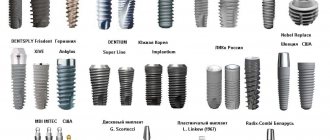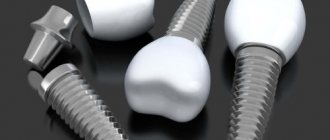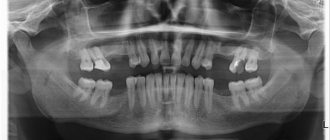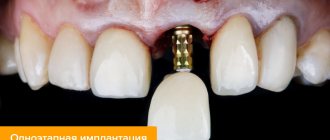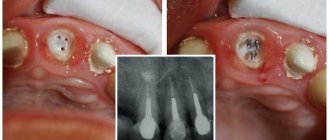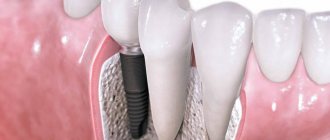All kinds of dental implants, or in other words, implants and implants, have firmly entered our lives and are no longer perceived as something unnatural. The invention of implantation - the implantation of artificial materials into the human body to replace lost organs - was a real breakthrough in medicine and science. Today, implants are used in many areas of medicine: these are artificial joints, silicone breast implants, and, of course, dental implants, which are available in almost every dentistry in Moscow.
History of the first patient
The first attempts to replace lost teeth with artificial ones were made by people in antiquity and even earlier. In the form in which we know dental implants now, they appeared in the second half of the 20th century. The first successful implantation was performed in 1965 on an ordinary carpenter, Gust Larsson, who lost all his lower teeth at the age of 34, had a cleft palate, a deformed upper jaw and chin, and experienced constant pain and significant difficulty eating and speaking. Larsson volunteered for a new study led by Professor Ingvar Brånemark at the University of Gothenburg, which Güsta had heard about by chance from his dentist. After the treatment, he was able to chew, eat and speak normally. The installed implants served Gust Larsson all his life. The experience of this brave man proved that installing dental implants is the most effective way to restore lost teeth.
Dental implants – what are they?
Dental implants, implants, implants are all artificial structures that replace missing teeth. They are firmly fixed in the bone tissue of the jaw and serve as a reliable support for fixed or removable dentures in the form of single crowns and bridges of varying lengths (you can see what dental implants look like in the photo above). There are several types of dental implants, but the most popular today are root-shaped dental implants, which have earned favorable reviews from both patients and leading implantologists around the world. Prices for dental implants depend on their quality, features of the installation system, the presence of special coating and other factors. Which implants are better is a topic for a separate article.
Photo of a dental implant
What is a pin and how is it different from an implant?
A pin is a rod that is installed into the root of a tooth. With its help, you can preserve the natural root and strengthen the crown part. Most often, this treatment method is used for severe tooth decay; the main condition for the procedure is strong root canals.
The pins are different:
- by material of manufacture (fiberglass, ceramics, metal, carbon fiber);
- by shape (cylindrical, conical, screw, cylindrical-conical);
- according to the method of fixation (screw, cement).
The doctor decides which pin to place depending on the specific situation.
Pin installation stage
- Removal of dental tissues affected by caries.
- Pulp removal.
- Preparing the dental canal for the installation of a pin.
- Trying on the rod.
- Procedures for treating the surface, channels, pin.
- Filling the channels with adhesive and fixing the pin.
Next, the crown part of the tooth is restored with filling materials or a crown if the tooth is destroyed by more than a third.
When is treatment with a pin not possible?
- root walls are destroyed;
- the root walls are not thick enough to install the pin;
- presence of gum disease;
- presence of a dental cyst.
How do dental implants take root?
What material are dental implants made of? The answer to this question will help us understand why they take root well. Almost all of the newest dental implants are made from titanium. This unique material is ideal for the manufacture of artificial tooth roots, since it is not perceived by the human body as something foreign and is not itself subject to the destructive effects of the surrounding biological environment. But the most important thing is that it can reliably fuse with the jawbone. These unique properties of titanium solved the problem of rejection and made implantation a reliable and durable technique. However, in very rare cases when a patient is allergic to titanium dental implants, zirconium dioxide is used as a base to make the prosthesis.
How long does it take for a dental implant to take root? Experts believe that the survival of dental implants is an individual process. The timing of osseointegration depends on the area of the dentition in which the implantation was performed, as well as on the quality of the bone tissue. In general, the healing of dental implants lasts from three months on the lower jaw and up to six months on the upper jaw. If the implantation is successful, then removal of the prosthesis becomes almost impossible, which proves the reliability of the structure. What is the survival rate of dental implants that worries many patients? It varies among different manufacturers, but in general it does not exceed 5%. In addition, the success of the operation is also influenced by the skill of the implant surgeon, so the choice of dentistry should be approached with special care.
What is better to put on chewing and front teeth?
If the incisors or molars are well treated, only the crown part is destroyed, and the root is not affected by caries, there are no cracks or inflammations, crowns can be placed. But you need to choose the right materials.
Restoration of the anterior incisors must meet high aesthetic requirements. The best option is a single prosthesis made of metal-free ceramics (it has natural translucency, is as similar as possible to natural enamel, but does not withstand heavy chewing loads).
Chewing molars are subject to severe stress, so it is important that the restoration method is reliable. You should choose durable materials, the best is zirconium dioxide - it is not inferior in strength to metal ceramics, but is more aesthetically pleasing and durable.
If the dentist has doubts about the quality of treatment, it is better to perform an extraction and install implants. There are methods of immediate implantation immediately after removal into a fresh socket - this will shorten the treatment time, there is no need to wait for healing or restoration of bone tissue.
For anterior incisors, a prosthetic restoration can be placed immediately using an immediate loading protocol. It is better not to load chewing teeth immediately, but to carry out classical implantation with delayed loading, because implants can become dislodged when chewed.
Lifespan of dental implants
Although implantation is significantly more expensive than traditional prosthetics, with a long-term calculation the costs are equalized. This is due to the fact that traditional bridges, crowns, clasp or nylon dentures need to be replaced on average every 5 to 7 years, and the supporting teeth will have to be ground down again each time. How long does a dental implant last? The minimum service life of a dental implant is about 30 years, and if all the doctor’s instructions are followed, the implant will last you a lifetime. Most manufacturing companies, including world industry leaders, who invest considerable funds in the latest developments, provide a multi-year or even lifetime warranty on their products. This applies to the part of the structure that is located inside - that is, the root (base plate, etc.) and the abutment. A crown installed on an abutment has a more limited service life, but it is also significantly longer than that of a traditional prosthesis installed on ground natural teeth. This is on average 10 – 15, sometimes 20 years. If we are talking about implantation for a young person, then, of course, he will be interested in what happens to implants in old age. With proper care and preventive examinations, nothing should happen to the artificial root.
Dental implants: reviews, harm, contraindications
On the websites of dental clinics they publish reviews about the installation of implants, prices of teeth, types, and manufacturers. Objectively, patients evaluate the price of treatment, the attitude of dentists, and the results in the first weeks after surgery. But who will write a review 5-7 years after surgery? Reading reviews, you can find information about rejections of structures, but the patient does not objectively determine whether this is the doctor’s fault.
The dentist’s skill is evidenced by photographs in which it is impossible to distinguish between your teeth and implanted teeth; the gums retain their natural color. Objective feedback on the quality of implants can be given by implantologists who have been practicing for more than 5 years.
Pros of implantation
The average survival rate of implanted dental structures after 5-7 years is 95-98%. In dentistry, dental implantation is becoming a frequently performed operation. It is safe; cases of rejection and development of dangerous complications are less than 5%. When implanting rods and installing fixed dentures on them, the dentist does not touch the adjacent teeth, does not grind them down, does not remove nerves, and the patient retains his healthy teeth longer, which are more reliable than implants, bridges, and removable dentures.
When implanting teeth, the price for 1 tooth from manufacturers AlphaBio, MIS, Osstem with a metal-ceramic crown is almost equal to the price of preparing one patient and two adjacent healthy teeth for the installation of a fixed bridge.
Having implanted implants in a patient, the dentist installs permanent bridges even in the absence of teeth, which is impossible with other treatment methods.
Minuses
In negative reviews from patients, more complaints are not about the rejection of dental structures, but about a change in the color of the gums under successfully implanted implants, exposing their neck. The cause of unpleasant changes is bone atrophy. But they can be slowed down if structures that cause minimal atrophy are installed (AstraTech, Straumann, NobelBiocare). You can avoid blueness of the gums under the incisors and fangs, noticeable when talking or smiling, by abandoning metal rods. Bioceramics does not enter into chemical reactions with tissues and does not change their color.
Rapid subsidence of the jaw bone under an implanted tooth is associated with the wrong choice of dental structure, implantation technique, errors during surgery or subsequent prosthetics.
Before implanting a dental structure, the dentist measures the thickness of the bone. The distance between the rod and the front surface of the gum must be at least 2 mm, otherwise it will atrophy faster (the level decreases by more than 1 mm per year). To prevent this, the implantologist can do additional tissue grafting and increase the bone volume.
But even with normal bone thickness, atrophy can be increased due to the thin biotype of the gum. It can be increased by transplanting a piece of mucous taken from the palate.
Atrophy also increases due to the close distance of the rods to the roots of adjacent teeth. It must be at least 3 mm. It also needs to be maintained if two implants are installed side by side.
Take your doctor's advice with an open mind. And if you doubt that there is a reason to do an indirect plastic surgery, install a specific dental structure, or perform a one-stage or two-stage operation, get an independent consultation from a dentist in another clinic.
General and specific contraindications
Who is contraindicated for dental implants? Implantation is a surgical operation and, like any other operation, it has contraindications. They are divided into two types: general for any type of implantation and specific dental ones.
The following concomitant diseases are common to all types of implantation (and to surgical interventions in general):
- violation of coagulation (blood clotting), diabetes mellitus, tuberculosis, chronic rheumatism - these diseases complicate wound healing and implant placement;
- pregnancy and lactation;
- childhood and adolescence – children and adolescents continue to grow, and this is fraught with displacement of implants or their rejection, or slowdown in the growth of individual organs as a result of the installation of dental implants in them;
- diseases of bone tissue that reduce its regenerative abilities;
- diseases of the nervous system;
- cancer during exacerbation, HIV and AIDS, specific diseases of the immune system that weaken the body as a whole and do not allow it to recover after operations.
The following can be considered specific contraindications to dental implantation:
- when installing implants in the upper jaw, it is necessary to take into account such factors as the proximity of the sinuses (aka the maxillary sinuses), as well as the width and density of the bone at the point of contact of the jaw with the sinuses; in some cases, the implantation procedure may be preceded by a sinus lift;
- chronic, including inflammatory diseases of the oral mucosa;
- patient's failure to comply with oral hygiene;
- insufficient height and density of bone tissue at the site of proposed implantation (this applies to both the upper and lower jaws) - in such a case, bone grafting can correct the situation.
It is worth noting that diabetes and advanced age are not currently included in the list of contraindications for dental implantation.
Dental implants in the upper jaw
Risks of implantation
The survival rate of implants today is a record 99%. But no one will ever give 100%; it is impossible to eliminate all risks. Someone will definitely fall into this 1%. Complications during implantation are very rare, but they do occur. During implantation of an artificial root, the following may happen:
- Inflammation of the tissue around the implant (peri-implantitis).
The doctor will rule out the cause of the inflammation and treat the root with special solutions. In case of relapse, the implant will have to be removed and the bone tissue will have to be restored. - Implant rejection.
It happens extremely rarely. The artificial root is removed. - The implant is unscrewed together with the plug.
This may occur during abutment placement. In the absence of inflammation, the titanium root is put in place. - The implant is pushed into the maxillary sinus.
In such cases, only removal of the titanium root will help. - Exposing the upper part of the implant.
A fairly common complication that affects aesthetics more than health.
Caring for Dental Implants
Many patients who have had artificial teeth installed are concerned about the question: how to care for dental implants? In fact, caring for artificial teeth is practically no different from regular oral hygiene. The same few basic rules apply here: regularity, thoroughness, correctness. That is, you need to brush your teeth at least twice a day - in the morning and before bed, and preferably after every meal, especially after eating carbohydrates; this must be done for at least three minutes, and also use additional hygiene products: dental floss, irrigator, etc.; You need to brush your teeth correctly - with sweeping movements away from the gums. The same brushes that are used for cleaning natural teeth are suitable for cleaning dental implants, but you can purchase a special toothbrush for implants.
Meaning of terms
By delving into the depths of semantics, you can understand how to correctly say - implant or implant.
- Implant is a word originally from France, translated as “transplant”. It serves to designate a dental prosthesis. In English there is the word “implant”, it stands for “implantation” and “transplantation”.
- The implant has the ending “-at, -ant”, indicating action. It is present in words such as “saboteur” (a person who ensures the creation of sabotage), “prisoner” (a person in prison). Likewise, the term “implant” refers to the person who installs the dentures (in other words, the dentist).
- Implant is a colloquial version of the word, formed as a result of incorrect pronunciation of the word “implant” (perhaps the cause of confusion was the word “transplant”, by analogy with which they began to add an extra suffix).
Thus, the question of which is correct - “implant” or “implant” - is not entirely correct. Since the second term has already become firmly established in dental terminology, its use is not a gross error. You can say “implants”, “implants” or “implants”, but remember that the first two terms refer to a tooth, and the third refers to a person.
Dental implants – pros and cons
As for expert opinions, the majority of specialists are inclined to argue for dental implants, and those who are usually against are either very elderly doctors or dentists who do not have sufficient qualifications to carry out such procedures. If we consider the pros and cons of dental implants, then among the undeniable advantages we can note durability, the absence of the need to grind adjacent teeth, in contrast to the installation of bridges, as well as the preservation of all the functions of a natural tooth, such as: full participation in chewing and speech, prevention of tooth loss bone tissue and changes in facial features. As for the disadvantages, the price becomes a significant difficulty for most patients, however, as mentioned above, this is an adequate cost of solving the problem once for a lifetime. As for an alternative to dental implants, it does not exist as such, since traditional prosthetics is inferior to it in all respects.
Dental implants make it possible to improve the quality of life, restore the full functionality of the dentition, restore the attractiveness of the smile, and also protect yourself from the loss of bone tissue in the place of the missing tooth, and therefore from the possibility of losing neighboring teeth. But, in any case, only an implantologist can confirm the need for this operation; he will also help you draw up a treatment plan and choose designs that suit you personally.
Make an appointment:
1. Dental clinic on the street. 50 Let Oktyabrya, 24, office 2/2: Tel 2. Dental clinic on the street. Permyakova, 73: +7 3452 51-40-47
Feelings during surgery
Installing 1 implant feels like removing one tooth. Doctors make this comparison when patients ask them what to expect from dental implant surgery. In most cases, artificial roots are implanted under local anesthesia. But patients who begin to worry even before the operation begin are sedated with local anesthesia. This is not a painkiller, but a sedative, relieves stress, anxiety, and increases the pain threshold. The patient remains conscious, but in a state close to deep sleep. Painful impulses are blocked, fear and anxiety go away, while the contact between the patient and the doctor is maintained. After sedation, there are no memories of the operation, neither good nor bad.
Severe fear, particularly complex treatment, complex dental implantation - in these cases the patient can be put to sleep using anesthesia. He falls asleep with a toothless mouth and wakes up with teeth.

